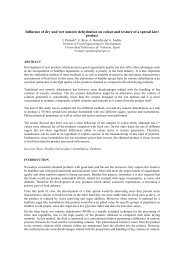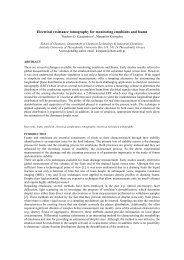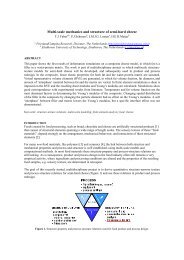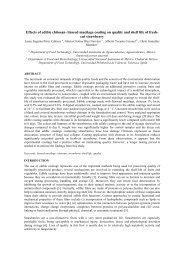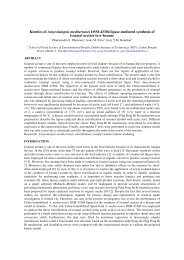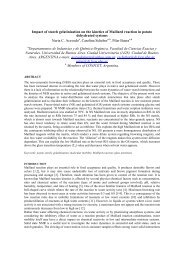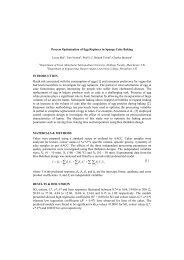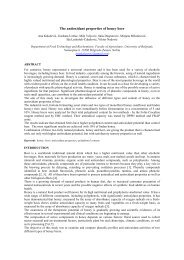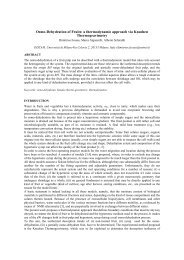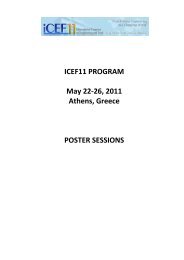The effect of UHT and VAT thermal processing - 11th International ...
The effect of UHT and VAT thermal processing - 11th International ...
The effect of UHT and VAT thermal processing - 11th International ...
You also want an ePaper? Increase the reach of your titles
YUMPU automatically turns print PDFs into web optimized ePapers that Google loves.
<strong>The</strong> Effect <strong>of</strong> <strong>UHT</strong> <strong>and</strong> <strong>VAT</strong> <strong>The</strong>rmal Processing Systems on Whey Protein<br />
Denaturation <strong>and</strong> Gel Strength <strong>of</strong> yoghurt<br />
ABSTRACT<br />
Labropoulos, A a ., Varzakas, T., b , Anestis, S. a<br />
a TechnologicalEducational Institute <strong>of</strong> Athens, Hellas (athanlab@teiath.gr)<br />
b Technological Educational Institute <strong>of</strong> Kalamata, Hellas (tvarzakas@teikal.gr)<br />
Milk was <strong>thermal</strong>ly processed by Ultra-High-Temperature (<strong>UHT</strong>, 132 to 154 0 C for 0 to 12 sec) <strong>and</strong> Vat<br />
(<strong>VAT</strong>, 66 0 C to 88 0 C for 0 to 30 min) systems. Representative milks were fermented into gels by a<br />
traditional yoghurt fermentation procedure. Selected functional properties, i.e. whey protein denaturation, gel<br />
strength, <strong>and</strong> their interrelationship were studied. Denaturation behavior <strong>of</strong> the five whey proteins indicates<br />
different heat <strong>effect</strong>s produced by the <strong>UHT</strong> <strong>and</strong> <strong>VAT</strong> heat treatments. <strong>The</strong> degree <strong>of</strong> whey protein<br />
denaturation increased at a faster rate in the <strong>UHT</strong> than in the <strong>VAT</strong> heat treatments. <strong>The</strong> <strong>UHT</strong> heat treatment<br />
resulted in yoghurt gels <strong>of</strong> lower strength than those <strong>of</strong> <strong>VAT</strong> heat treatments. A critical point was found in<br />
the optimal gel strength in the <strong>UHT</strong> (149 0 C, 3.3 sec) heat treatment. An approximate correlation between<br />
the degree <strong>of</strong> whey protein denaturation <strong>and</strong> the gel strength was observed in the <strong>VAT</strong> heat treatment,<br />
whereas no such correlation was found in the <strong>UHT</strong> heat treatment. It appeared, therefore, that whey protein<br />
denaturation in the <strong>UHT</strong> <strong>and</strong> <strong>VAT</strong> heat treatments plays a markedly different role in the mechanism <strong>of</strong><br />
yoghurt gelation. Moreover, the <strong>VAT</strong> but not the <strong>UHT</strong> heat treatment may provide an index <strong>of</strong> the gel<br />
strength.<br />
Keywords: Whey proteins, gel strength, denaturation, <strong>UHT</strong> process, <strong>VAT</strong>, yogurt<br />
INTRODUCTION<br />
It is well known that different process variables can induce changes in the physical properties <strong>of</strong> milk<br />
proteins. Such variables affecting physical properties <strong>of</strong> proteins include heat treatment, protein content,<br />
acidity, etc. <strong>The</strong>re is considerable controversy, however, regarding temperature-time relationships necessary<br />
to change the physical property <strong>of</strong> a product, e.g. stability [1].<br />
Moreover, heating <strong>of</strong> milk proteins to temperatures exceeding normal pasteurization levels by <strong>UHT</strong> <strong>and</strong> <strong>VAT</strong><br />
<strong>processing</strong> systems Influences the physical properties <strong>of</strong> yoghurt consistency [2]. Parnell-Clunies et al. [1]<br />
found the highest viscosity in <strong>VAT</strong> heat treatments (85 0 C, 10-40 min), while <strong>UHT</strong> heat treatments (140 0 C,<br />
2-8 sec) gave remarkably lower viscosity.<br />
<strong>The</strong>re are many studies concerning the heat-denaturation <strong>of</strong> milk proteins but very few <strong>of</strong> them describe the<br />
relation <strong>of</strong> denaturation to other functional properties [3]. Elsewhere, it has been indicated that heat<br />
treatments <strong>of</strong> 78 0 C for 1 hr or 80 0 C for 30 min or 90 0 C for 5 min is required for complete denaturation <strong>of</strong><br />
milk proteins [4]. McKenzie [5] claimed that prolonged exposure to denaturation will cause extensive<br />
unfolding <strong>of</strong> proteins leading eventually to cleavage <strong>of</strong> disulfide groups <strong>and</strong> other complicated reactions<br />
which could affect the functional properties <strong>of</strong> the products. For example, excessive <strong>UHT</strong> heat treatment <strong>of</strong><br />
milk resulted in co-precipitation <strong>of</strong> the denatured whey proteins with the caseins <strong>and</strong> loss <strong>of</strong> the desirable<br />
functional property, i.e. curd strength, <strong>of</strong> cottage cheese [6]. Also, it was claimed by these authors that the<br />
interaction <strong>of</strong> beta-lactoglobulin with caseins after a heat treatment improves the consistency <strong>of</strong> buttermilk<br />
gel. A statistical model was used to study the maximum range <strong>of</strong> factors <strong>and</strong> their <strong>effect</strong> on fouling using the<br />
minimum number <strong>of</strong> experiments. <strong>The</strong>se factors included the amount <strong>and</strong> rate <strong>of</strong> the denaturation <strong>of</strong> b –<br />
lactoglobulin comparing the amount <strong>of</strong> b -lactoglobulin reaction with the fouling <strong>of</strong> a multichannel Plate heat<br />
exchanger. [7].<br />
A number <strong>of</strong> factors such as milk quality, composition/ additives, <strong>and</strong> the <strong>processing</strong> conditions have been<br />
shown to influence the gelation <strong>of</strong> <strong>UHT</strong> treated milk [8]. Similar studies have shown that a gelation <strong>effect</strong> can<br />
be caused by severe distortion <strong>of</strong> casein micelles <strong>and</strong> their formation <strong>of</strong> a three-dimensional network or by<br />
the precipitation <strong>of</strong> casein micelles to form sediment [9]. Others found that there was no correlation between
gelation <strong>and</strong> protein breakdown in <strong>UHT</strong> processed milks [10]. But the exact mechanism <strong>of</strong> gelation in <strong>UHT</strong><br />
milk is not clearly understood [11].<br />
Sedlmeyer <strong>and</strong> Kulozik [12] investigated the <strong>effect</strong> <strong>of</strong> the heating temperature in the range <strong>of</strong> 120–139°C <strong>and</strong><br />
the filling temperature after cooling down to 4–14°C prior to storage for 24 <strong>and</strong> 96 h at 4 °C on a system<br />
comprising milk <strong>and</strong> 400 ppm kappa-2 type <strong>of</strong> carrageenan. <strong>The</strong> textural properties <strong>and</strong> the stability <strong>of</strong> such<br />
systems mainly depend on the interaction <strong>of</strong> the carrageenan <strong>and</strong> the casein micelle surface which was<br />
assessed by means <strong>of</strong> the hysteresis loop area between the upward <strong>and</strong> downward flow curves upon variation<br />
<strong>of</strong> the shear stress. During storage, a further influence <strong>of</strong> the process parameters on structural development<br />
between casein <strong>and</strong> carrageenan was observed. Structure point analysis, small angle oscillatory rheology <strong>and</strong><br />
particle size measurements were used for further explanation <strong>of</strong> the results <strong>of</strong> the hysteresis loop area.<br />
Studies clearly show that high protein concentration can greatly influence the formation mechanisms <strong>of</strong> whey<br />
protein gels. Fickak et al. [13] used a laboratory produced heat induced whey protein gels (HIWPG) <strong>and</strong> a<br />
pilot plant heat exchanger fouling/cleaning to investigate the <strong>effect</strong> <strong>of</strong> protein concentration on formation <strong>and</strong><br />
cleaning <strong>of</strong> dairy fouling.<br />
<strong>The</strong> Viscolab (Tetra Pak), an indirect ultra-high treatment (<strong>UHT</strong>) pilot plant, was used by Depypere et al.<br />
[14] to prepare dairy desserts containing kappa-carrageenan, skimmed milk powder (SMP), adipate crosslinked<br />
acetyl-substituted waxy maize starch, sucrose <strong>and</strong> water. Effects <strong>of</strong> varying concentrations <strong>of</strong><br />
carrageenan, milk powder <strong>and</strong> starch on the dessert rheology were studied. <strong>The</strong>y found that the dessert<br />
preparation in an <strong>UHT</strong> pilot plant involved a more intense heat treatment. As a result, a more extensive whey<br />
protein denaturation <strong>and</strong> subsequent complexation with casein micelles is believed to contribute to the<br />
rheological properties <strong>of</strong> the <strong>UHT</strong> desserts.<br />
<strong>The</strong>refore, it is <strong>of</strong> interest to determine the degree <strong>of</strong> whey protein denaturation induced by different<br />
<strong>processing</strong> systems <strong>and</strong> the correlation <strong>of</strong> denaturation to the gel strength. <strong>The</strong> current study examines the<br />
<strong>effect</strong> <strong>of</strong> two process systems i.e. continuous <strong>UHT</strong> <strong>and</strong> batch <strong>VAT</strong> heat treatments, on the denaturation <strong>of</strong><br />
whey proteins with a view to further correlation with the mechanism <strong>of</strong> gel strength in yoghurt.<br />
MATERIALS & METHODS<br />
<strong>The</strong>rmal Processing<br />
Raw whole milk was heat treated by two <strong>processing</strong> systems, i.e. a continuous <strong>UHT</strong> <strong>and</strong> a batch <strong>VAT</strong>,<br />
represented by the following temperature-process holding time combinations: <strong>UHT</strong> <strong>processing</strong> at<br />
temperatures 132 0 C to 154 0 C with an app. 6 0 C increment for 0.0, 1.2, 3.3, 5.2, 9.0, <strong>and</strong> 12.0 sec <strong>and</strong> <strong>VAT</strong><br />
<strong>processing</strong> at temperatures 66 0 C to 88 0 C with an app. 6 0 C increment for 0.0, 5.0, 10.o, 20.0, <strong>and</strong> 30 min.<br />
Unheated milk was utilized as a control.<br />
<strong>UHT</strong> <strong>and</strong> <strong>VAT</strong> heat treatments were carried out in a helically coiled tube, with an indirect heating system,<br />
automatic temperature control <strong>and</strong> in a steam jacketed batch type pasteurizer respectively. Different residence<br />
times were obtained by using holding tubes <strong>of</strong> varying length size <strong>and</strong> changing pump speeds in the <strong>UHT</strong><br />
process system. All heat treatments were homogenized at 60 0 C preheating temperature <strong>and</strong> an approximate<br />
105 Kg/cm 2 operating pressure.<br />
Preparation <strong>of</strong> Gel<br />
After homogenization <strong>and</strong> cooling to approx. 43°C, milk was inoculated with 3% mixed yoghurt culture<br />
(Streptococcus thermophilus <strong>and</strong> Lactobacillus bulgaricus at a 1:1 ratio) <strong>and</strong> incubated at 43 0 C until a pH <strong>of</strong><br />
4.5 was obtained (Fig. 1). <strong>The</strong>n, it was stored at refrigeration temperature for further analysis.<br />
Gel Strength Measurements<br />
For relative comparisons between heat treatments <strong>of</strong> the two <strong>processing</strong> systems, yoghurt gels were subjected<br />
to a st<strong>and</strong>ard procedure (one day-old, unstirred 4 0 C yoghurt gel strength measurement). A Cherry-Burrel<br />
curd tension meter was used to measure the strength <strong>of</strong> yoghurt gels. Total breaking energy (gel strength or<br />
curd tension values) was expressed in grams required to penetrate approx. 6 cm deep into the body <strong>of</strong> the<br />
yoghurt gel with a round plunger.<br />
Whey Protein Separation<br />
Diverse heat treated milks <strong>and</strong> the control (unheated) were acidified to pH 4.6 at 35 0 C, centrifuged (1000 x g<br />
15 min, 4 0 C), <strong>and</strong> filtered (Whatman no. 1 paper) to an acid whey solution which was ten-fold concentrated<br />
by treating 10 ml with l.8 g lyphogen medium for 4 hrs prior to electrophoresis. <strong>The</strong> whey proteins were<br />
separated on cellulose acetate strips using the electrophoresis procedure <strong>of</strong> Morr [15] as modified by Bell <strong>and</strong>
Stone [16] for separating blood serum proteins. <strong>The</strong> electrophoretic strips were scanned at 525 nm with a<br />
DCD-16 densitometer (Gelman Instrument Co., Ann Arbor, Mi). <strong>The</strong> instrument was set to yield nearly full<br />
scale peaks for the beta-lactoglobulin. A peak <strong>of</strong> the control sample (raw, unheated whey proteins) was<br />
employed in each experimental set.<br />
Qualitative analysis <strong>of</strong> the whey protein fractions was made according to the procedure <strong>of</strong> Puyol et al. [17] in<br />
which the whey protein fractions <strong>of</strong> the milk are identified by the rate <strong>of</strong> travel in the electric field relative to<br />
st<strong>and</strong>ard proteins. Purified samples <strong>of</strong> bovine albumin <strong>and</strong> bovine globulins were obtained from Calbiochem,<br />
Lajolla, CA, whereas alpha-lactalbumin, beta-lactoglobulln A <strong>and</strong> beta-lactoglobulin B were obtained from<br />
Sigma Chemical Co., St. Louis, MO.<br />
Protein Denaturation Measurements<br />
<strong>The</strong> whey protein denaturation was expressed as a percentage resulting from the relation <strong>of</strong> the curve area <strong>of</strong><br />
each heat treated sample to the corresponding area <strong>of</strong> the unheated sample.<br />
Quantitative analysis <strong>of</strong> protein denaturation was made by measuring the total area under the densitometer<br />
tracing curves using a 620005 compensating planimeter (Keuffer <strong>and</strong> Esser Co., NY).<br />
RESULTS & DISCUSSION<br />
Effect <strong>of</strong> heat treatment on whey protein electrophoresis<br />
A typical densitometer tracing <strong>of</strong> separation <strong>of</strong> whey proteins <strong>of</strong> raw milk is shown in Fig. 2. <strong>The</strong>re were 5<br />
distinct electrophoretic peaks, corresponding to immunoglobulins (Igs), alpha-lactalbum in A (alpha-La),<br />
beta-lactoglobulin B (beta-Lg B), beta-lactoglobulin A (beta-Lg A), <strong>and</strong> bovine serum albumin (BSA).<br />
Progressive decreases in the area <strong>of</strong> electrophoretic peaks occurred with an increase in process holding time,<br />
for example, at the <strong>UHT</strong> system (149 0 C) <strong>and</strong> at the <strong>VAT</strong> system (82 0 C) as you can see in Figures 3 & 4,<br />
respectively. Qualitative analysis <strong>of</strong> the areas under the electrophoretic peaks for the <strong>UHT</strong> treatments at 132<br />
0 C through 154 0 C showed that these treatments with no process holding times did not severely denature the<br />
whey proteins (Fig. 5). A significant denaturation was observed at l49 0 C <strong>and</strong> above as is evident in Figure 5.<br />
However, the same <strong>UHT</strong> treatments but with 12 sec process holding times yielded a complete denaturation<br />
for all the temperatures applied to whey proteins (Fig. 6).<br />
On the other h<strong>and</strong>, <strong>VAT</strong> treatments at 66 0 C for 0 through 30 min process holding times indicated only a<br />
small <strong>effect</strong> on whey protein denaturation. Figure 7 shows that at <strong>VAT</strong> heat treatments 66 0 C through 88 0 C<br />
with 0 sec process holding time. <strong>The</strong>re was a severe denaturation <strong>effect</strong> somewhere between 82 0 C <strong>and</strong> 88 0 C<br />
temperatures (Fig. 7). When <strong>VAT</strong> heat treatments were applied at various temperatures with a constant 30<br />
min process holding time, a substantial denaturation <strong>effect</strong> was obtained after 71 0 C temperature (Fig. 8).<br />
However, it is obvious from the results that the cumulative <strong>effect</strong> <strong>of</strong> temperature <strong>and</strong> process holding time on<br />
the area under the electrophoretic tracing curves was substantially different between the <strong>UHT</strong> <strong>and</strong> <strong>VAT</strong> heat<br />
treatments. This was found to be particularly apparent at the higher temperatures <strong>of</strong> both <strong>processing</strong> systems<br />
where the areas under the electrophoretic tracing curves were markedly affected by process holding times.<br />
Effect <strong>of</strong> heat treatments on whey protein denaturation<br />
Among whey protein properties, denaturation Induced by <strong>thermal</strong> processes is <strong>of</strong> considerable importance. A<br />
differential sensitivity <strong>of</strong> whey protein denaturation to <strong>UHT</strong> <strong>and</strong> <strong>VAT</strong> processes was observed. For example,<br />
a <strong>UHT</strong> heat treatment at 149 0 C for 3.3 sec caused a 70% denaturation <strong>of</strong> the total whey proteins.<br />
Analytically, the result above was due to the denaturation <strong>of</strong> 80% Igs, 45% alpha-La, 70% beta-Lg B, 75%<br />
beta-Lg A, <strong>and</strong> 60% BSA. However, an amount equal to 95% denaturation <strong>of</strong> whey proteins was caused<br />
either by the <strong>UHT</strong> <strong>thermal</strong> <strong>processing</strong> (l49 0 C, 6 sec) or by the <strong>VAT</strong> <strong>thermal</strong> <strong>processing</strong> (82 0 C, 5 min).<br />
Overall, the heat <strong>effect</strong> on whey protein denaturation indicates that alpha-La is the most resistant whey<br />
protein followed by the Igs, beta-Lg A <strong>and</strong> beta-Lg B. <strong>The</strong> results above are similar to other literature<br />
observations [18]. From the results in this study, it is obvious that the degree <strong>of</strong> total whey protein<br />
denaturation or the denaturation <strong>of</strong> the predominant beta-Lactoglobulins could provide an index <strong>of</strong> the <strong>UHT</strong><br />
<strong>and</strong>/or <strong>VAT</strong> heat treatments applied to various processed milks <strong>and</strong> to other similar products. Table 1 shows<br />
the progressive denaturation (decrease in the peak area) <strong>of</strong> the whey protein, i.e. beta-lactoglobulins, as a<br />
function <strong>of</strong> <strong>UHT</strong> process holding time at 138 <strong>and</strong> 149 0 C temperatures. However, two regions near 70 0 C <strong>and</strong><br />
130 0 C have been attributed to the denaturation <strong>and</strong>/or unfolding <strong>of</strong> residual protein structure <strong>of</strong> betalactoglobulins<br />
according to Kirn et al. [19].
Effect <strong>of</strong> heat treatment on gel strength<br />
Whey proteins have been demonstrated to participate in gel formation, while other studies have shown that<br />
heat treatment (conventional or <strong>UHT</strong>) <strong>of</strong> milk affects the rheological properties <strong>of</strong> yoghurt gel prepared from<br />
this milk [2]. However, a differential <strong>effect</strong> <strong>of</strong> <strong>VAT</strong> <strong>and</strong> <strong>UHT</strong> heat treatments on the gel strength <strong>of</strong> yoghurt<br />
made by the above <strong>processing</strong> systems was observed in this study. Gel strength measured by curd tension<br />
values ranged between 15 <strong>and</strong> 34.5 g for the <strong>UHT</strong> heat treatments <strong>and</strong> reached up to 85 g for the <strong>VAT</strong> heat<br />
treatments (Table 2). <strong>The</strong> strength <strong>of</strong> yoghurt gels prepared from <strong>UHT</strong> heat treatments was, thus, always<br />
lower than those prepared from <strong>VAT</strong> heat treatments. It is obvious, therefore, the following explanation: <strong>The</strong><br />
higher holding times applied in the <strong>UHT</strong> heat treatments seem to have a specific <strong>effect</strong> on some kind <strong>of</strong><br />
casein-whey protein-mineral interactions which in turn^ reduce the capacity <strong>of</strong> the network system to form<br />
high strength gels.<br />
Since beta-lactoglobulins compose 40-60% <strong>of</strong> the normal whey proteins, they should have a major<br />
contribution to gel strength. Investigators have noted that beta-lactoglobulin is the most important predictor<br />
<strong>of</strong> gel strength at pH 8.0 but not at pH 4.6 – 6.5. It is, also, well known that beta-lactoglobulins are the major<br />
source <strong>of</strong> sulfhydryl groups in whey proteins, so it might be possible that the sulfhydryl-disulfide interchange<br />
can make an important contribution to the formation <strong>of</strong> a gel matrix.<br />
Effect <strong>of</strong> heat denaturation on gelation<br />
A rough correlation between the extent <strong>of</strong> whey protein denaturation <strong>and</strong> gel strength was found for the <strong>VAT</strong><br />
heat treatments. For example, a heat treatment for 30 minutes at 66 0 C yielded only moderate denaturation<br />
<strong>and</strong> a considerably higher degree <strong>of</strong> the gel strength. No such correlation was observed for <strong>UHT</strong> heat<br />
treatments in relation to the gel strength. Although a progressive increase in protein denaturation with<br />
increasing process holding time at 149 0 C was found (Fig. 3), the strength <strong>of</strong> the yoghurt gel reached its<br />
maximum at 3.3 sec process holding time (Table 2). However, the degree <strong>of</strong> gel strength was found lower<br />
than the above at shorter or longer process holding times. It was, also, observed that the strength <strong>of</strong> yoghurt<br />
gels prepared from <strong>UHT</strong> heat treatments was lower than those prepared from <strong>VAT</strong> heat treatments regardless<br />
<strong>of</strong> the degree <strong>of</strong> denaturation.<br />
<strong>The</strong> lack <strong>of</strong> correlation between whey protein denaturation <strong>and</strong> degree <strong>of</strong> gel strength <strong>of</strong> yoghurts may reflect<br />
the lesser contribution <strong>of</strong> the <strong>UHT</strong> heat treatments to the matrix formation <strong>of</strong> the gel.<br />
<strong>The</strong> gelation <strong>of</strong> yoghurt is presumably a process which takes place in two stages. One corresponds to a slow<br />
unfolding (denaturation) <strong>of</strong> the proteins <strong>and</strong> the other to an aggregation (intermolecular disulfide)<br />
hydrophobia, hydrogen, <strong>and</strong> ionic bond reactions). During the second stage if it is sufficiently slow, a well<br />
ordered network may be formed due to intermolecular bind formation. If denaturation is too rapid <strong>and</strong>/or too<br />
extensive as with <strong>UHT</strong> heat treatments, there may be excessive local coagulation <strong>of</strong> protein <strong>and</strong> thus a<br />
weaker strength <strong>of</strong> gel results. <strong>The</strong> extent <strong>of</strong> denaturation <strong>of</strong> the whey proteins With progressive <strong>UHT</strong><br />
process holding time resulted in an increased strength <strong>of</strong> gels to a maximum point (149 0 C, 3.3 sec.) after<br />
which a decreased strength <strong>of</strong> gels started to occur. This could be a result <strong>of</strong> the sediment <strong>effect</strong> which is<br />
observed at the higher <strong>UHT</strong> heat treatments, which in turn could be the main factor for the reduction <strong>of</strong> gel<br />
strength in yoghurt.<br />
<strong>The</strong> respective degree lactogloglobulins at two temperatures <strong>and</strong> progressively longer process holding times<br />
as shown in Table 1 was ranged between 56 <strong>and</strong> 96%. <strong>The</strong> degree <strong>of</strong> gel strength for the <strong>VAT</strong> heat treatments<br />
increased progressively during the increased holding process times, while for the <strong>UHT</strong> heat treatments<br />
subsequently declined after a certain point, i.e. 149 0 C at 3.3 sec. According to de Witt <strong>and</strong> Swinkels (1980),<br />
the heat denaturation <strong>of</strong> a protein reflects the stability <strong>of</strong> the native structure. <strong>The</strong> increase in denaturation is<br />
correlated with an increase in yoghurt gel hardness for the <strong>VAT</strong> heat treatments, while denaturation <strong>of</strong> whey<br />
proteins was not associated with the degree <strong>of</strong> gel strength <strong>of</strong> yoghurt when <strong>UHT</strong> heat treatments were<br />
applied. <strong>The</strong>se indicate that the high temperatures <strong>of</strong> the <strong>UHT</strong> could possibly have some specific <strong>effect</strong>s on<br />
casein-whey protein or whey protein-mineral interactions which in turn may reduce the capacity o£ the<br />
casein-whey protein-mineral system to forma high strength gel. <strong>The</strong>se results could, also, be due to factors<br />
such as the sedimentation, an <strong>effect</strong> which can be due to interactions <strong>and</strong> co-precipitation <strong>of</strong> whey proteins,<br />
caseins <strong>and</strong> minerals, especially at the higher <strong>UHT</strong> heat treatments where it was observed to be increased.
Table 1.<br />
Effect <strong>of</strong> <strong>UHT</strong> heat treatment at 138<br />
Process Holding Time<br />
0 C <strong>and</strong> 149 0 C on b-lactoglobulin.<br />
Electrophoretic Area<br />
Denaturation<br />
(sq. cm)<br />
(%)<br />
(sec)<br />
138 0 C 149 0 C 138 0 C 149 0 C<br />
0.0 5.7 4.2 40 56<br />
1.2 3.6 2.2 62 77<br />
3.3 1.9 1.7 80 82<br />
5.2 1.0 1.2 90 92<br />
9.0 0.9 0.4 91 96<br />
12.0 0.7 -- 93 --<br />
Note: - Average values <strong>of</strong> triplicate measurements<br />
- Area <strong>of</strong> raw (unprocessed) sample was shown 9.5 cm 2 value for the b-Lactoglobulin fraction.<br />
Table 2.<br />
Effect <strong>of</strong> <strong>UHT</strong> <strong>and</strong> <strong>VAT</strong> heat treatments on gel strength <strong>of</strong> yoghurt.<br />
HEAT TREATMENT<br />
Process Holding Time<br />
(sec)<br />
Process Temperature<br />
( 0 C)<br />
Gel<br />
Strength<br />
(g)<br />
<strong>UHT</strong> 0.0 149 24<br />
<strong>UHT</strong> 3.3 149 33<br />
<strong>UHT</strong> 5.2 149 27<br />
<strong>UHT</strong> 9.0 149 14<br />
<strong>UHT</strong> 12.0 149 12<br />
<strong>VAT</strong> 1800.0 82 86<br />
Note: - Average curd tension values <strong>of</strong> at least triplicated measurements.<br />
Figure 1: Flow diagram <strong>of</strong> traditional <strong>VAT</strong> <strong>and</strong><br />
<strong>UHT</strong> yoghurt <strong>processing</strong><br />
Figure 2: Electrophoretic pattern (densitometric<br />
tracing) <strong>of</strong> whey proteins in raw whole milk (unheated)
Figure 3: Electrophoretic patterns <strong>of</strong> whey proteins<br />
<strong>of</strong> whole milk <strong>thermal</strong>ly processed by the <strong>UHT</strong><br />
system at 149°C temperature <strong>and</strong> 0 to 12 sec process<br />
holding times.<br />
Figure 5: Electrophoretic patterns <strong>of</strong> whey proteins<br />
<strong>of</strong> whole milk <strong>thermal</strong>ly processed by the <strong>UHT</strong><br />
system at 132°C to 154°C temperatures <strong>and</strong> a<br />
constant 0 sec process holding time<br />
Figure 4: Electrophoretic patterns <strong>of</strong> whey proteins <strong>of</strong><br />
whole milk <strong>thermal</strong>ly processed by the <strong>VAT</strong> system at<br />
82°C temperature <strong>and</strong> 0 to 40 min process holding<br />
times.<br />
Figure 6: Electrophoretic patterns <strong>of</strong> whey proteins <strong>of</strong><br />
whole milk <strong>thermal</strong>ly processed by the <strong>UHT</strong> system at<br />
132°C to 154°C temperatures <strong>and</strong> a constant 12 sec<br />
process holding time.
Figure 7: Electrophoretic patterns <strong>of</strong> whey proteins<br />
<strong>of</strong> whole milk <strong>thermal</strong>ly processed by the <strong>VAT</strong><br />
system at different process holding times <strong>of</strong> 5, 20,<br />
30 min <strong>and</strong> at constant process temperature <strong>of</strong> 66<br />
°C.<br />
Figure 9. Electrophoretic patterns <strong>of</strong> whey proteins<br />
<strong>of</strong> whole milk <strong>thermal</strong>ly processed by the <strong>VAT</strong><br />
system at 66°C to 82°C temperatures <strong>and</strong> a constant<br />
30 min process holding time<br />
Figure 8: Electrophoretic patterns <strong>of</strong> whey proteins <strong>of</strong><br />
whole milk <strong>thermal</strong>ly processed by the <strong>VAT</strong> system at<br />
66°C to 88°C temperatures <strong>and</strong> a constant 0 min<br />
process holding time.
CONCLUSION<br />
<strong>The</strong> results <strong>of</strong> this study indicate that electrophoresis on cellulose acetate membranes provides a relatively<br />
simple <strong>and</strong> quick procedure for separating <strong>and</strong> measuring the relative quantities <strong>of</strong> protein denaturation<br />
induced by different <strong>thermal</strong> <strong>processing</strong> operations. Denaturation <strong>of</strong> the whey proteins induced by <strong>UHT</strong> <strong>and</strong><br />
<strong>VAT</strong> <strong>processing</strong> systems was dependent on <strong>thermal</strong> <strong>processing</strong> systems <strong>and</strong> <strong>thermal</strong> <strong>processing</strong> parameters<br />
(process holding time <strong>and</strong> temperatures). A rough correlation between extent <strong>of</strong> whey protein denaturation<br />
<strong>and</strong> gel strength was found for the <strong>VAT</strong> heat treated whey proteins, while no such correlation was observed<br />
in the <strong>UHT</strong> heat treated whey proteins. On the other h<strong>and</strong>, the strength <strong>of</strong> gels prepared with the <strong>UHT</strong><br />
process was always lower than those prepared with the <strong>VAT</strong> process. This could lead to production <strong>of</strong> light<br />
strength gels with an application to drinkable or semi-liquid products.<br />
REFERENCES<br />
[1] Parraell-Clunies, E. M., Kakuda, Y., <strong>and</strong> Deman, J. M. 1986. Influence <strong>of</strong> heat treatment <strong>of</strong> milk on the<br />
flow properties <strong>of</strong> yoghurt. Journal <strong>of</strong> Food Science, 51, 1459-1467.<br />
[2] Labropoulos, A., Lopez, A., <strong>and</strong> Palmer, J. 1981b. Apparent viscosity <strong>of</strong> milk <strong>and</strong> cultured yoghurt<br />
<strong>thermal</strong>ly treated by <strong>UHT</strong> <strong>and</strong> <strong>VAT</strong> systems. Journal <strong>of</strong> Food Protection, 44, 874-892.<br />
[3] Rector, D.J.., Matsudomi, N., <strong>and</strong> Kinsella, J. E. 1991. Changes in gelling behavior <strong>of</strong> whey protein<br />
isolate <strong>and</strong> beta-lactoglobulin during storage: Possible Mechanism (s). Journal <strong>of</strong> Food Science, 56, 783-787.<br />
[4] Webb, B. H., Johnson, A. H., <strong>and</strong> Alford, J. A. 1974. Fundamentals <strong>of</strong> Dairy Chemistry. 2nd Ed. the Avi<br />
Publ. Co., Inc., West-port, CT.<br />
[5] Mc Kenzie, H. A. 1971. Milk Proteins. Acad. Press, Inc., New York, N.Y.<br />
[6] Harper, W. J. <strong>and</strong> Hall, C. W. 1976. Dairy Technology <strong>and</strong> Engineering. Avi Publ. Co., Inc., Westport,<br />
CT.<br />
[7] Fryer, P.,J., Robbins, P.T., Green, C., Schreier, P.J.R., Pritchard, A.M., Hasting, A.P.M., Royston, D.G.,<br />
<strong>and</strong> Richardson, J.F. 1996. Statistical model For Fouling <strong>of</strong> a Plate Heat Exchanger by whey Protein Solution<br />
at <strong>UHT</strong> Conditions. Transactions Institute <strong>of</strong> Chemical Engineers, 74 (C), 189-199.<br />
[8] Harwalkar, V. R. 1982. Age gelation <strong>of</strong> sterilized milks. In: Developments in Dairy Chemistry. Edit. by<br />
P. F. Fox., p. 229-265. London: Applied Science.<br />
[9] Mc Kenna, A. B. <strong>and</strong> Singth, H. 1991. Age gelation in <strong>UHT</strong>-processed reconstituted concentrated skim<br />
milk. <strong>International</strong>. Journal <strong>of</strong> Food Science & Technology, 26, 27-34.<br />
[10] Samel, R., Weaver, W. V., <strong>and</strong> Gammack, D. B. 1971. Change on storage in milk processed by ultrahigh-temperature<br />
sterilization. Journal <strong>of</strong> Dairy Research, 38:323.<br />
[11] deKonnig, P. J., Kaper, J., Rollerma, H. S., <strong>and</strong> Driessen, F. M. 1985. Age-thinning <strong>and</strong> gelation in<br />
unconcentrated <strong>and</strong> concentrated <strong>and</strong> <strong>UHT</strong>-sterilized skim milk. Effect <strong>of</strong> native milk proteinase. Netherl<strong>and</strong>s<br />
Milk Dairy Journal, 39, 71-73.<br />
[12] Sedlmeyer, F., <strong>and</strong> Kulozik, U. 2006. Impact <strong>of</strong> process conditions on the rheological detectable<br />
structure <strong>of</strong> <strong>UHT</strong> treated milk protein–carrageenan systems. Journal <strong>of</strong> Food Engineering, 77, 943-950.<br />
[13] Fickak, A., Al-Raisi, A., <strong>and</strong> Chen, X.D. 2011. Effect <strong>of</strong> whey protein concentration on the fouling <strong>and</strong><br />
cleaning <strong>of</strong> a heat transfer surface. doi:10.1016/j.jfoodeng.2010.11.004.<br />
[14] Depypere, F., Verbeken, D., Torres, J.D. <strong>and</strong> Dewettinck, K. 2009. Rheological properties <strong>of</strong> dairy<br />
desserts prepared in an indirect <strong>UHT</strong> pilot plant. Journal <strong>of</strong> Food Engineering, 91, 140-145.<br />
[15] Morr, C. V. 1975. Procedure I. In methods <strong>of</strong> gel electrophoresis <strong>of</strong> milk proteins. H. Swalsgood, Ed.,<br />
Am. Dairy Sci. Assoc. Champaign, IL.<br />
[16] Bell, J. W. <strong>and</strong> Stone, W. K. 1979. Rapid separation <strong>of</strong> whey proteins by cellulose acetate<br />
electrophoresis. Journal <strong>of</strong> Dairy Science 62, 502-507.<br />
[17] Puyol, P., Perez, M.D., Horne, D.S., 2001. Heat-induced gelation <strong>of</strong> whey protein isolates (WPI): <strong>effect</strong><br />
<strong>of</strong> NaCl <strong>and</strong> protein concentration. Food Hydrocolloids 15, 233–237.<br />
[18] Hillier, R. M., Lyster, R. J., <strong>and</strong> Cheeseman, G. C. 1979. <strong>The</strong>rmal denaturation <strong>of</strong> alpha-lactalbumin<br />
<strong>and</strong> beta-lactoglobulin in cheese whey; Effect <strong>of</strong> total solids concentration <strong>and</strong> pH. Journal <strong>of</strong> Dairy<br />
Research, 46, 103-109.<br />
[19] Kirn, Y. A., Chism, G. W. III, <strong>and</strong> Mangino, M. E. 1987. Determination <strong>of</strong> the beta-lactoglobulin,<br />
alpha-lactalbumin, <strong>and</strong> bovine serum albumin <strong>of</strong> whey protein concentrates <strong>and</strong> their relationship to protein<br />
functionality. Journal <strong>of</strong> Food Science, 52, 124-128.



